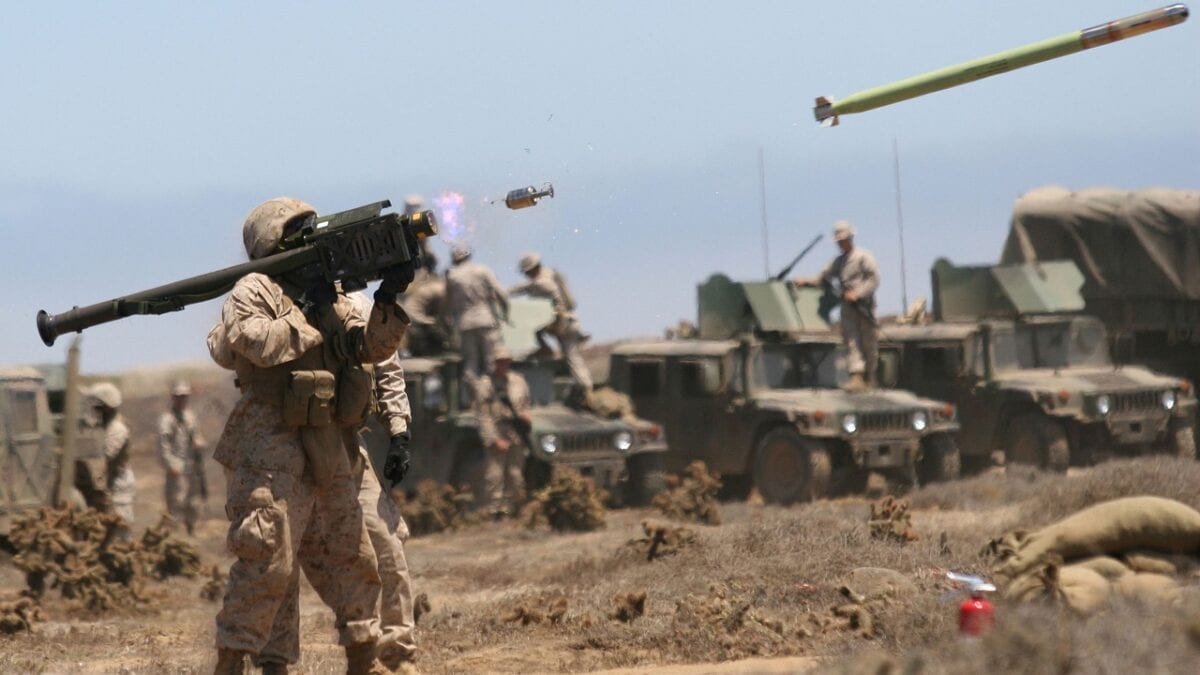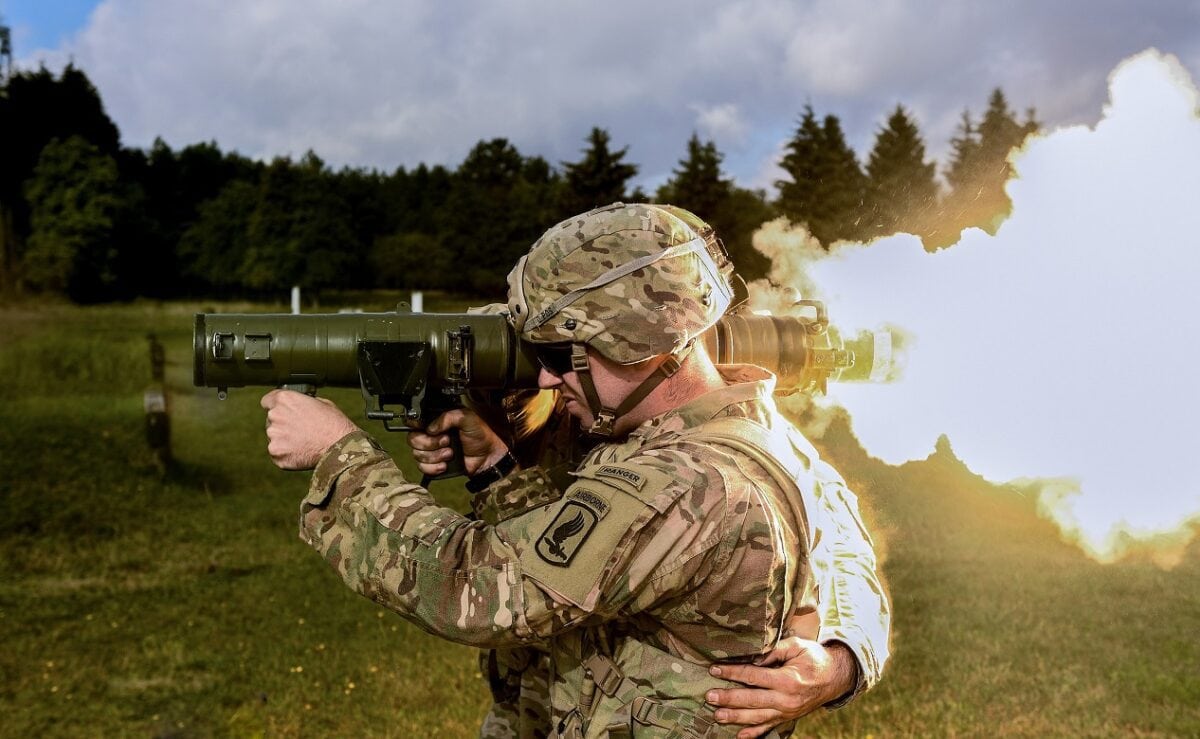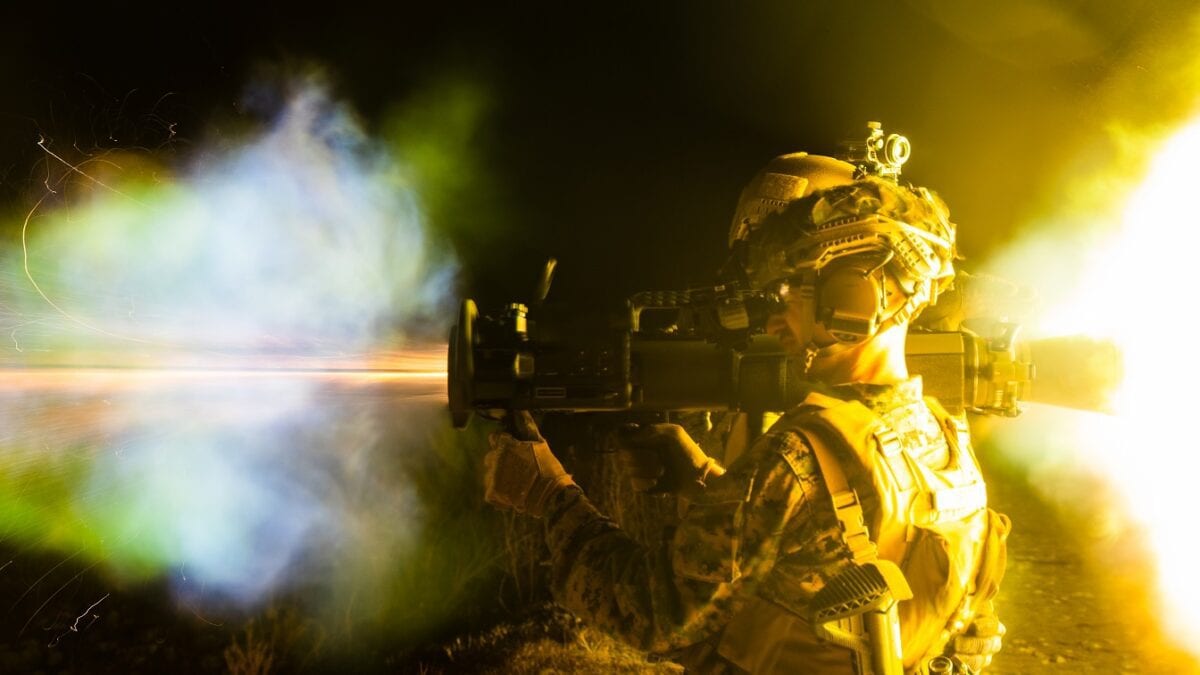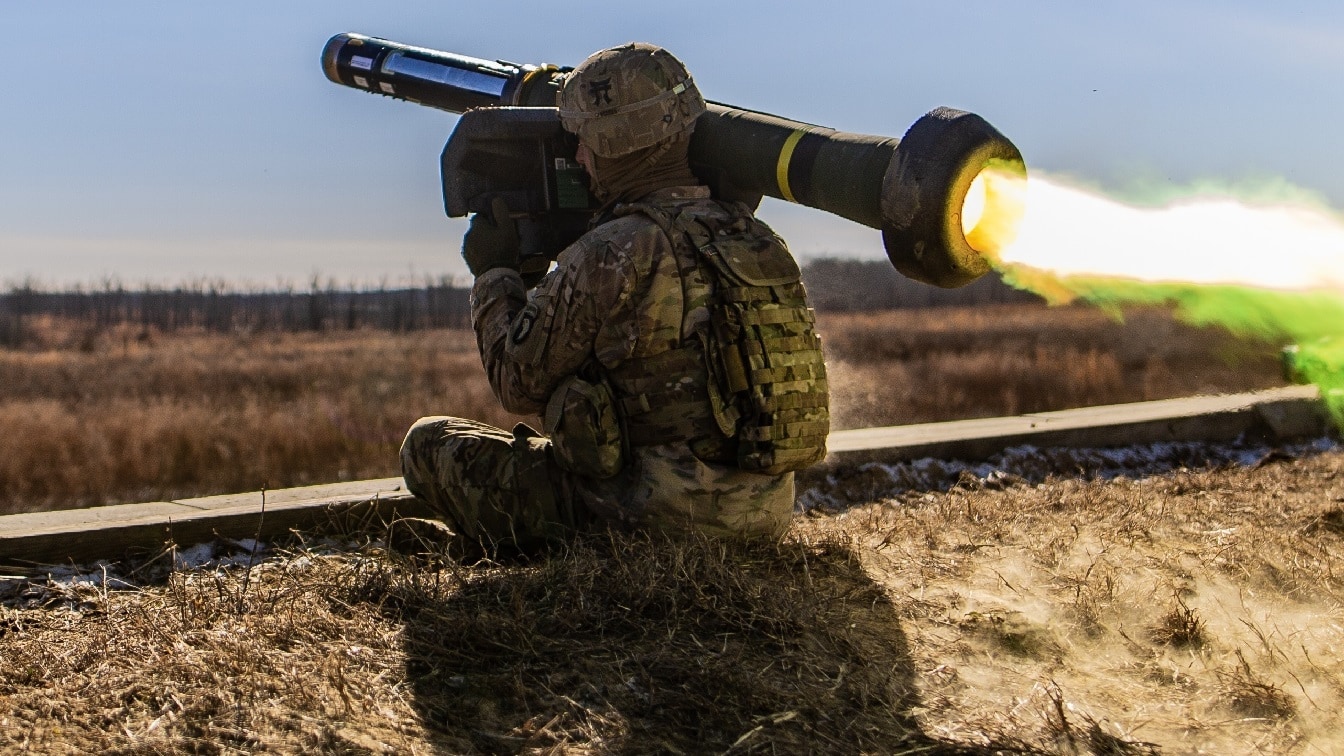Europe and America Are Giving Thousands of Tank- and Aircraft-Busting Missiles to Ukraine—Here’s What They Can Do – Nations across Europe, both members, and non-members of the NATO alliance, are delivering an unprecedented quantity of military assistance to Ukraine as it seeks to fight Russian troops invading from the North, East and South.
While large quantities of small arms, body armor, and medical supplies are making their way to Ukraine, undoubtedly the weapons Kyiv needs most are portable anti-tank and anti-aircraft weapons which can be easily integrated and rapidly employed by Ukrainian units without requiring extensive training and new logistical support infrastructure.
Ukraine’s military was not completely lacking such arms before—but it does need lots more of them to deal with the sheer volume of invading Russian armored vehicles and helicopters. Many donor nations are clearing out inventories of retired weapons to send to Ukraine, but cutting-edge systems like Javelins are also making their way to Ukraine’s defenders.
This article surveys contributions of anti-tank and anti-aircraft weapons to Ukraine in 2022 with an eye as to their effectiveness and how they might be employed tactically in defense of Ukraine. A companion article surveys other kinds of arms and equipment European states are furnishing.

Stinger missile being fired. Image Credit: Creative Commons.
Man-Portable Air Defense Missiles (MANPADS)
- 160 9K32 Strela-2 (SA-7) missiles and 10 launchers from Czech Republic
- 300 Stingers (unassembled) from Denmark
- Stingers from Latvia (delivered February 23)
- Stingers from Lithuania (delivered February 13)
- 200 Stinger missiles and 50 launchers from the Netherlands
- 500 Stinger missiles from Germany
- 2,700 9K32M Strela-2M (SA-7B) missiles from Germany (approved March 3)
- Stinger missiles from Italy
- Piorun missiles (improved Igla) from Poland
- 100 most likely SA-18 (9K38 Igla) Grouse launchers and 486 anti-air/tank missiles from Slovakia
- “Missiles” from France, likely Mistral MANPADS, as France has “acted on earlier requests for defense anti-aircraft weapons”
- Additional Stingers from the United States
Man-portable air defense systems (MANPADS) pose a serious threat to low-flying aircraft, particularly helicopters and drones, but also warplanes like the Su-25 Frogfoot that swoop down to attack targets with rockets and cannon fire. However, warplanes (but not so many helicopters) can fly above the range of most MANPADS to release gravity bombs with reduced accuracy, or precision weapons.
Russia has employed helicopters surprisingly aggressively (arguably even recklessly) to insert troops behind Ukrainian lines despite substantial short-range air defenses present, and has lost several Ka-52 attack helicopters and Su-25 attack jets. Thus, helping Ukraine deploy a higher more MANPADS could contribute to further Russian aircraft losses, even if each individually can only protect a limited area. In the video below you can see and hear MANPADS launch at Russian helicopters.
#war The footage was shot near Vyshgorod, 20 km from ??Kiev. pic.twitter.com/ug8x7Viu4a
— Capt(N) (@Capt_Navy) February 24, 2022
The most important contribution comes in the form of U.S.-built FIM-92 Stinger missiles, which gained notoriety for inflicting steep losses in the Russian war in Afghanistan. The Stinger have a maximum altitude of 11,500 feet, and a superior probability of hit compared to earlier MANPADS thanks to its combined infrared and negative-ultraviolet light seeker which is apt at disregarding flare decoys.
Soviet-built Strela-2M missiles contributed by Germany and the Czech Republic date back to the 1960s-1970 and can only engage jets flying at subsonic speeds from the rear, though slower helicopters and propeller aircraft can be engaged from additional angles at up to 12,467 feet. The Strela’s infrared seeker is easily led astray by flare decoys, and its small 2.5-pound warhead often fails to disable the target.
The Strela’s 1980s-era successor, the Igla (being supplied by Slovakia), has more flexible engagement windows, is less likely to be decoyed, and has a ceiling of 17,000 feet.
More powerful longer-range air defense syste, are unfortunately too large and technically complex to rapidly integrate into Ukrainian service, though any remaining Soviet short-range air defense vehicles in NATO stocks might still be transferrable and useable by Ukraine.
Light Anti-Tank Rockets, Single-Shot Disposable
- 200 M72A2 LAW one-shot anti-tank weapons Belgium
- 4,500 M72A5 and/or M72A7 LAW from Canada (announced March 3)
- 2,700 M72A7 LAW or ECLAW one-shot anti-tank weapons from Denmark
- 1,500 “disposable anti-tank weapons” from Finland (likely APILAS or M72A2 or A5)
- Portable rocket launchers from Greece (probably AT4)
- 100 NLAW anti-tank weapons from Luxembourg
- 2,000 NM72F1 (ie. M72A6) LAW from Norway
- 486 anti-air/anti-tank missiles, likely including RPG-75, from Slovakia
- 5,000 Pansarskott m/86 (ie. Bofors AT4) recoilless anti-tank weapon from Sweden
- Over 2,000 NLAW missiles from United Kingdom (delivered January)
One-shot disposable light anti-tank weapons have limited range, but are so portable that a few can be carried in every infantry squad and employed against armored vehicles should opportunity arise.
They are most useful in dense urban or forested areas where short lines of sight and abundant concealment make close engagements common. They may also be used in a pinch against enemy personnel in cover.
Light anti-tank weapons, however, usually can’t penetrate the frontal armor Russian main battle tanks protected by composite and explosive reactive armor that’s especially efficient against non-kinetic warheads. However, such weapons remain effective against most other armored vehicles.
Of these weapons, NLAW missiles given by the U.K. and Luxembourg are the most capable due to their predictive guidance system, longer maximum range of 600-800 meters, and partial top-attack mode giving it a chance to penetrate more heavily armored tanks.
Ukraine also requested NLAWs from Finland Sweden (where it’s designated RB-57) and Italy, but received older weapons, notably, the 14.8-pound Swedish-exported AT4 (M136 in U.S. service). These recoilless weapons have a range of 300/500 meters against moving/stationary targets and can penetrate around 450 millimeters of armor, though produce a large back blast.
On the lighter side, the eight-pound M72 LAW has a maximum effective range of 200-220 meters. The ECLAW subvariant can penetrate 450 millimeters and the lighter 5.5-lb M72A2 and A5, 300 millimeters. The M72A6 and A7 model have reduced armor penetration (150mm) but improved blast effect. Ukraine is to receive at least 9,400 M72s of various marks.
The Slovak RPG-75 has an effective range 200-300 meters and can penetrate 330 millimeters.
Light Anti-Tank Weapons, Reusable
- “rockets” or “missiles and “ammunition” from Australia (likely Carl Gustaf M3, though single-shot AT4 or even Javelins also possible)
- “rockets” from Greece, likely Carl Gustaf M2
- 100x Carl Gustaf 84mm M2 or M3 anti-tank weapons and 2,000 rounds from Canada
- Panzerfaust 3 or MILAN ATGMs from Italy
- 50 Panzerfaust 3-T launchers and 400 rockets from The Netherlands
- Ammunition for 73mm recoilless rifles from Poland
Reusable light-antitank weapons tend to be heavier, but can contribute anti-tank firepower more sustainably.
The Carl Gustaf is a venerable family of portable recoilless rifles which can fire rapidly if needed, and penetrate up to 400 millimeters of armor out to an effective range of 400 meters. Like the AT4, it generate a significant backblast. The M2 models weigh 31 pounds, the newer M3, 22 pounds.

Carl Gustaf Firing: Sky Soldiers from 1st Battalion, 503rd Infantry Regiment engaged targets with the Carl Gustaf 84mm weapon system in Grafenwoehr, Germany September 8, 2018 during Saber Junction 18. Exercise Saber Junction 18 is a U.S. Army Europe-directed exercise designed to assess the readiness of the U.S. Army’s 173rd Airborne Brigade to execute unified land operations in a joint, combined environment and to promote interoperability with participating allies and partner nations.

U.S. Marine Corps Lance Cpl. Hunter Cross, a native of Midlands, Mich., and a combat engineer with 2d Combat Engineer Battalion, 2d Marine Division, fires an M3E1 multipurpose anti-armor anti-personnel weapon system (MAAWS) on Camp Lejeune, N.C., Dec. 9, 2021. The MAAWS, also known as the Carl Gustaf, is a man-portable, reusable, breech-loading, 84 mm recoilless rifle capable of destroying armored targets. (U.S. Marine Corps photo by Lance Cpl. Brian Bolin Jr.)
The punchier German-built Panzerfaust 3 has a single-shot launch canister but a reusable firing and sighting system; it produces little backblast, allowing firing from enclosed spaces, and can hit moving targets out to 300 meters, or 600 using a Dynarange laser sight. Its 110-millimeter warhead has a tandem charge powerful to penetrate 900mm RHA, threatening the frontal armor of many Russian main battle tanks.
Long-range Anti-Tank Guided Missiles
- Javelins from Estonia (delivered 2/18 and 2/25)
- Possibly Javelins from Poland
- Additional Javelins from the United States
Anti-tank guided missiles (ATGMs) are heavier guided weapons that can engage main battle tanks from over a mile away. This allows for more proactive engagement of main battle tanks which ordinarily attempt to remain outside the range of light anti-tank weapons.
The FGM-148 Javelin is arguably the world’s best (and most expensive) portable ATGM. While some rival ATGMs have maximum ranges exceeding the Javelin’s 2.5 miles, it has several big advantages: fire-and-forget capability thanks to its infrared-seeker and ability to launch high-arcing top attacks which can penetrate the thinner top armor of just about any tank. That even includes tanks with reactive and cage armor thanks to a precursor charge at the weapon’s tip designed to disable such defenses.
These qualities have made Javelins heavily in demand for Ukraine. Kyiv has also requested Israeli-built Spike missiles used by several countries including Italy and the Baltic States. The Spike not only has very long range but in some instances can be remotely piloted to the target like a drone; these factors mean it could be employed to target enemy artillery, not just tanks. However, Israel has blocked Spike clients from transferring them to Ukraine prioritizing relations with Moscow, which has a major presence in neighboring Syria.
Sébastien Roblin writes on the technical, historical, and political aspects of international security and conflict for publications including the 19FortyFive, The National Interest, NBC News, Forbes.com, and War is Boring. He holds a Master’s degree from Georgetown University and served with the Peace Corps in China. You can follow his articles on Twitter.

